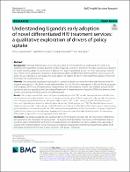| dc.contributor.author | Henry, Zakumumpa | |
| dc.contributor.author | Japheth, Kwiringira | |
| dc.contributor.author | Cordelia, Katureebe | |
| dc.contributor.author | Neil, Spice | |
| dc.date.accessioned | 2023-05-26T07:35:45Z | |
| dc.date.available | 2023-05-26T07:35:45Z | |
| dc.date.issued | 2023 | |
| dc.identifier.citation | Zakumumpa, H., Kwiringira, J., Katureebe, C., & Spicer, N. (2023). Understanding Uganda’s early adoption of novel differentiated HIV treatment services: a qualitative exploration of drivers of policy uptake. BMC Health Services Research, 23(1), 1-14. | en_US |
| dc.identifier.uri | https://doi.org/10.1186/s12913-023-09313-x | |
| dc.identifier.uri | https://hdl.handle.net/20.500.12504/1356 | |
| dc.description.abstract | Background
Although differentiated service delivery (DSD) for HIV treatment was endorsed by the WHO in its
landmark 2016 guidelines to lessen patients’ need to frequently visit clinics and hence to reduce unnecessary burdens
on health systems, uptake has been uneven globally. This paper is prompted by the HIV Policy Lab’s annual report of
2022 which reveals substantial variations in programmatic uptake of differentiated HIV treatment services across the
globe. We use Uganda as a case study of an ‘early adopter’ to explore the drivers of programmatic uptake of novel differentiated HIV treatment services.
Methods
We conducted a qualitative case-study in Uganda. In-depth interviews were held with national-level HIV
program managers (n = 18), district health team members (n = 24), HIV clinic managers (n = 36) and five focus groups
with recipients of HIV care (60 participants) supplemented with documentary reviews. Our thematic analysis of the
qualitative data was guided by the Consolidated Framework for Implementation Research (CFIR)’s five domains (inner
context, outer setting, individuals, process of implementation).
Results
Our analysis reveals that drivers of Uganda’s ‘early adoption’ of DSD include: having a decades-old HIV treatment intervention implementation history; receiving substantial external donor support in policy uptake; the imperatives of having a high HIV burden; accelerated uptake of select DSD models owing to Covid-19 ‘lockdown’ restrictions; and Uganda’s participation in clinical trials underpinning WHO guidance on DSD. The identified processes of implementation entailed policy adoption of DSD (such as the role of local Technical Working Groups in domesticating global guidelines, disseminating national DSD implementation guidelines) and implementation strategies (high-level health ministry buy-in, protracted patient engagement to enhance model uptake, devising metrics for measuring DSD uptake progress) for promoting programmatic adoption.
Conclusion
Our analysis suggests early adoption derives from Uganda’s decades-old HIV intervention implementation experience, the imperative of having a high HIV burden which prompted innovations in HIV treatment delivery
as well as outer context factors such as receiving substantial external assistance in policy uptake. Our case study of
Uganda offers implementation research lessons on pragmatic strategies for promoting programmatic uptake of differentiated treatment HIV services in other countries with a high HIV burden. | en_US |
| dc.language.iso | en | en_US |
| dc.publisher | BMC Health Services Research | en_US |
| dc.subject | Antiretroviral therapy | en_US |
| dc.subject | HIV treatment | en_US |
| dc.subject | Differentiated service delivery | en_US |
| dc.subject | DSD | en_US |
| dc.subject | Case study | en_US |
| dc.subject | Health policy and systems | en_US |
| dc.subject | Uganda | en_US |
| dc.title | Understanding Uganda’s early adoption of novel differentiated HIV treatment services: a qualitative exploration of drivers of policy uptake | en_US |
| dc.type | Article | en_US |

